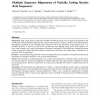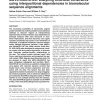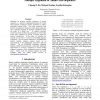20 search results - page 1 / 4 » Multiple sequence alignments of partially coding nucleic aci... |
BMCBI
2005
13 years 4 months ago
2005
Background: High quality sequence alignments of RNA and DNA sequences are an important prerequisite for the comparative analysis of genomic sequence data. Nucleic acid sequences, ...
NAR
2006
13 years 4 months ago
2006
The increasing availability of structurally aligned protein families has made it possible to use statistical methods to discover regions of interpositional dependenciesof residue ...
BMCBI
2005
13 years 4 months ago
2005
Background: Alignments of homologous DNA sequences are crucial for comparative genomics and phylogenetic analysis. However, multiple alignment represents a computationally difficu...
AAAI
2004
13 years 6 months ago
2004
Obtaining an accurate multiple alignment of protein sequences is a difficult computational problem for which many heuristic techniques sacrifice optimality to achieve reasonable r...
BMCBI
2008
13 years 4 months ago
2008
Background: Multiple sequence alignments are a fundamental tool for the comparative analysis of proteins and nucleic acids. However, large data sets are no longer manageable for v...



